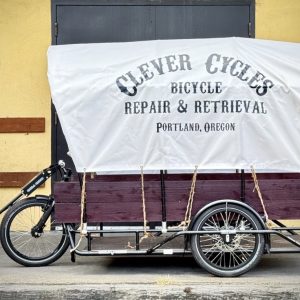participating businesses from Travel
Oregon. The program is free; signs cost
$26 to $56.
After a two-month pilot effort in Estacada and Cottage Grove, Oregon’s public tourism agency is going statewide with a program that publicly recognizes businesses for bike-friendly practices.
The idea is to create a well-recognized brand that can identify the state’s bike-friendly businesses by a sign in the window — which will, in turn, help bike tourists thank the businesses with their dollars.
In the long run, organizers hope, it’ll foster a culture of welcoming bikers at the state’s roadside diners, small-town hotels and big-city bars, similar to the 500 hotels now affiliated with Quebec’s “Welcome Cyclists” program. And that’ll help Oregon further improve its niche in the growing bike tourism industry.
“Enhancing the biking experience for visitors and Oregonians is one of our top initiatives at Travel Oregon,” Scott West, Travel Oregon’s chief strategy officer, wrote in a news release Tuesday.
The initiative, the first of its kind in the country, follows up on Oregon’s first-in-the-nation Scenic Bikeways program, launched in 2010.
It’s not too hard to get recognized by the new program. All businesses must offer at least two items on a long list of options (among them: “complimentary bike locks,” “bike tire floor pump,” “short-term bike parking on site,” “complimentary water,” “public bathrooms,” “dining,” “lodging” and/or “wifi”) and must fill out a short quiz about the merits of bike tourism. There are also several requirements specifically for lodging and food providers. (“High-carbohydrate food” is one way a restaurant can qualify, for example.)
The program is free to businesses. If a business wants to advertise its status with a metal sign, Travel Oregon will provide it at cost for $26 to $56 depending on type.
“If you were out riding your bike and you saw this sign, you’d probably be pretty excited,” Staj Pace, an organizer for the program, told Clackamas County residents at a bike-tourism summit near Mount Hood Saturday.
Phil Lingelbach, chair of the Estacada Development Association and an advocate for better bike amenities as a way to boost the area’s economy, said about half a dozen businesses in the Clackamas County city of 3,000 have participated in the pilot program so far.
“There’s a couple of them that have those little window stickers,” he said. “I think it’s just a matter of time. It’s pretty hard to get these small businesses to come to meetings, things like that.”
A 2012 study by Dean Runyan Associates estimated that tourists who bike while traveling the state (including Oregonians who travel at least 50 miles from their home for in-state trips) spend $400 million annually on such trips. It’s about 4 percent of the state’s total tourism revenue. Of those who do so, 63 percent are over age 45 and 57 percent have household incomes of $75,000 or more.
Lingelbach, and Travel Oregon, think bike tourists’ numbers are likely to keep growing.
Jae Heidenreich of Clackamas County’s tourism office said the advantages of welcoming bikers are becoming clear to residents and businesses in places like Estacada and Oregon City.
“Here are real-life people who are really interested in this natural beauty that we have,” she said.
You can learn more about the program from these Travel Oregon videos about it, including this one produced for Travel Oregon by Russ Roca and Laura Crawford of The Path Less Pedaled:





Thanks for reading.
BikePortland has served this community with independent community journalism since 2005. We rely on subscriptions from readers like you to survive. Your financial support is vital in keeping this valuable resource alive and well.
Please subscribe today to strengthen and expand our work.
Here’s one in Portland at Evan Ross’s shop Cycle Portland: http://instagram.com/p/ggTlJzAUSy/#
This program sounds great in theory, but my concern is that it sounds way too easy to qualify/be considered “bike-friendly.” If too many businesses have these signs displayed in their windows and just offer free water and a bike pump somewhere (dual presto/schraeder connections should be required) then displaying and seeing the signs will lose their value/impact. I think more stringent minimum requirements and possibly a slightly higher cost would help make this program and qualification more reasonable and effective.
yeah! signage that communicates services to a sub group of people that happen to move from point A to point B via a two wheeled vehicle totally loses it’s value when it’s placed all over a community, I mean who are all these handicapped people anyway? All you need to do to get a sign is have a slanty ramp, or reserved parking space? Totally worthless, I bet people who happen to be handicapped wish it was harder for businesses to relay that information to them and that it should cost more for those silly signs.
I had the same concerns after noting some of the options listed under the program requirements. I can’t think of many businesses that wouldn’t provide free water and (code-mandated) short-term bicycle parking. Requiring only two of the options seems to set the bar pretty low, and I can’t think of many businesses that wouldn’t qualify, especially based on the second half of the list from the website. At least the website also requires those offering lodging to have secure dry parking available, such as bringing bikes into rooms. I’ve always felt like I was “sneaking” them in and knowing it was allowed would be nice.
I’m not saying it isn’t a great program, it would just be more meaningful if the program is set up to support and recognize those businesses that go above and beyond.
PS Evan – Comparing an voluntary promotional business program to laws and requirements designed to protect the rights of a specific class of citizens, those with disabilities in this case, might not be the best analogy. Just a thought.
I agree. That was silly, but the analogy is not about the law/structure, its about the signs not losing their value. People who choose to transport themselves actively should be protected by the same rights as all road users.
I’m so proud to be a member of this program and think it has incredible value. After working for years on helping create a bike friendly business recognition program I want to thank Travel Oregon for spearheading the process and bringing local shop owners like myself in to the fold. Those of us who ride in the countryside or visit small towns throughout Oregon by bike know the value of having secure bike parking, or where we can fill our water bottles, and the easier it is to get that information the better.
Let’s keep in mind that this program is STATE wide. Yes, beyond metro Portland. The hope is that many businesses in rural parts of the state will participate, especially those along the Scenic Bikeways. So imagine after pedaling 50 miles on a hot day in the middle of Eastern, OR and you see a sign that advertises a business that is bike friendly, has water, a restroom you can use, etc., Godsend.